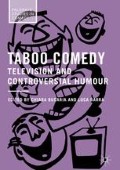Abstract
This chapter explores how narratives and images of death—both real and fictional—permeate contemporary media and reflect a society in which death is simultaneously concealed and exploited. In particular, it examines how the end of life is highly medicalized, secularized and mediatized, creating a unique set of social conditions that facilitate the creation and appreciation of humour about death. Through the analysis of scenes from a wide range of series, including Six Feet Under, The Big C, Grey’s Anatomy, Nurse Jackie and Last Man on Earth, this chapter reveals the imbrication of levity and bereavement in twenty-first century American TV. Despite its caustic and disruptive nature, dark comedy is a collective, provocative endeavor through which we attempt to articulate grief and ameliorate its impact.
Access this chapter
Tax calculation will be finalised at checkout
Purchases are for personal use only
Bibliography
Ariès, Phillippe. 1981. The Hour of Our Death. Oxford: Oxford University Press.
Bauman, Zygmunt. 1992. Survival as a Social Construct. Theory, Culture & Society 9: 1–36.
Becker, Ernest. 1997. The Denial of Death. New York: Touchstone Press.
Bergson, Henri. 1980. Laughter. In Comedy, ed. Wylie Sypher, 61–190. Baltimore: Johns Hopkins University Press.
Boskin, Joseph (ed). 1997. The Humor Prism in 20th Century America. Detroit: Wayne State University Press.
Buchanan, Maria, and Patrice Keats. 2011. Coping with Traumatic Stress in Journalism: A Critical Ethnographic Study. International Journal of Psychology 46(2): 127–135.
Crouch, Mira. 2004. Last Matters: The Latent Meaning of Contemporary Funeral Rites. In Making Sense of Dying and Death, ed. Andrew Fagan. Amsterdam: Rodopi.
Crouch, Mira, and Bernd Hüppauf. 1985. Introduction. In Essays on Mortality, ed. Mira Crouch, and Bernd Hüppauf, xi–xiii. Sydney: The University of New South Wales Faculty of Arts.
Davies, Christie. 2011. Jokes and Targets. Bloomington: Indiana University Press.
Davis, Jessica Milner. 2003. Farce. Transaction: New Brunswick.
Denzin, Norman. 1991. Images of Postmodern Society: Social Theory and Contemporary Cinema. London: Sage.
Erth, Spencer. 2002. Television Viewing as Risk Factor. Psychiatry 652: 301–303.
Feifel, Herman. 1977. New Meanings of Death. New York: McGraw-Hill.
Freud, Sigmund. 1960. Jokes and Their Relation to the Unconscious. Trans. James Strachey. London: Hogarth.
Gibson, Margaret. 2007. Death and Mourning in Technologically Mediated Culture. Health Sociology Review 165: 415–424.
Gorer, Geoffrey. 1995. The Pornography of Death. In Death: Current Perspectives, ed. John Williamson, and Edwin Shneidman, 18–22. London: Mayfield.
Greenfield, Patricia Marks. 1993. Representational Competence in Shared Symbol Systems: Electronic Media from Radio to Video Games. In The Development and Meaning of Psychological Distance, ed. Rodney R. Cocking, and Ann Renninger. Hillsdale: Lawrence Erlbaum Associates.
Hobbes, Thomas. 1997. In Leviathan, ed. Michael Oakeshott. New York: Touchstone.
Hockey, Jenny. 2007. Closing in on Death? Reflections on Research and Researchers in the Field of Death and Dying. Health Sociology Review 165: 436–446.
Höijer, Birgitta. 2004. The Discourse of Global Compassion: The Audience and Media Reporting of Human Suffering. Media, Culture & Society 246: 513–531.
Howarth, Glennys. 2000. Australian Funerals. In Death & Dying in Australia, ed. Alan Kellhear, 80–91. Melbourne: Oxford University Press.
Jalland, Pat. 2006. Changing Ways of Death in 20th Century Australia: War, Medicine and the Funeral Business. Sydney: University of New South Wales Press.
Kearl, Michael. 1995. Death in Popular Culture. In Death: Current Perspectives, ed. John Williamson, and Edwin Shneidman, 23–30. London: Mayfield.
Kellehear, Alan. 2000. The Australian Way of Death: Formative, Historical and Social Influences. In Death & Dying in Australia, ed. Alan Kellehear, 1–13. Melbourne: Oxford University Press.
———. 2007. A Social History of Dying. Cambridge: Cambridge University Press.
Lewis, Paul. 1997. The Killing Jokes of the American Eighties. Humor 103: 251–283.
Martin, Rod. 2007. The Psychology of Humor: An Integrative Approach. Burlington: Elsevier.
Mellor, Philip. 1993. Death in High Modernity: The Contemporary Presence and Absence of Death. In The Sociology of Death: Theory, Culture, Practice, ed. D. Clark, 11–30. Oxford: The Editorial Board of the Sociological Review.
Mellor, Philip, and Chris Shilling. 1993. Modernity, Self-Identity and the Sequestration of Death. Sociology 273: 411–431.
Mitford, Jessica. 2000. The American Way of Death. London: Virago.
Mittell, Jason. 2010. Television and American Culture. New York: Oxford University Press.
Moran, Carmen, and Margaret Massam. 1997. An Evaluation of Humour in Emergency Work. The Australasian Journal of Disaster and Trauma Studies 3: 26–38.
Najman, Jake. 2000. The Demography of Death: Patterns of Australian Mortality. In Death & Dying in Australia, ed. Alan Kellehear, 17–39. Melbourne: Oxford University Press.
Nuland, Sherwin B. 1997. How We Die. London: Vintage.
Palmer, Jerry. 1994. Taking Humour Seriously. London: Routledge.
Raskin, Victor (ed). 2008. The Primer for Humor Research. Boston: Mouten de Gruyter.
Rumbold, Bruce. 2000. Pastoral Care of the Dying and Bereaved. In Death & Dying in Australia, ed. Alan Kellehear, 284–297. Melbourne: Oxford University Press.
Scott, Tricia. 2007. Expression of Humour by Emergency Personnel Involved in Sudden Deathwork. Mortality 124: 350–364.
Seale, Clive. 2000. Changing Patterns of Death and Dying. Social Science and Medicine 512: 917–930.
Shoshana, Avi, and Elly Teman. 2006. Coming Out of the Coffin: Life-Self and Death-Self in Six Feet Under. Symbolic Interaction 294: 557–576.
Author information
Authors and Affiliations
Corresponding author
Editor information
Editors and Affiliations
Copyright information
© 2016 The Author(s)
About this chapter
Cite this chapter
Murray, K.A. (2016). The Last Laugh: Dark Comedy on US Television. In: Bucaria, C., Barra, L. (eds) Taboo Comedy. Palgrave Studies in Comedy. Palgrave Macmillan, London. https://doi.org/10.1057/978-1-137-59338-2_3
Download citation
DOI: https://doi.org/10.1057/978-1-137-59338-2_3
Published:
Publisher Name: Palgrave Macmillan, London
Print ISBN: 978-1-137-59337-5
Online ISBN: 978-1-137-59338-2
eBook Packages: Literature, Cultural and Media StudiesLiterature, Cultural and Media Studies (R0)

